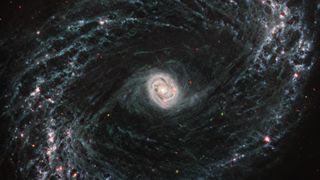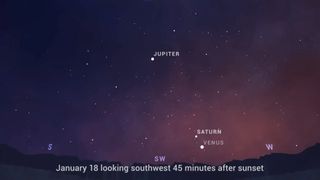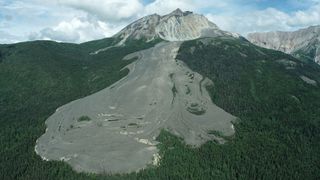Space.com contributing writer Stefanie Waldek is a self-taught space nerd and aviation geek who is passionate about all things spaceflight and astronomy. With a background in travel and design journalism, as well as a Bachelor of Arts degree from New York University, she specializes in the budding space tourism industry and Earth-based astrotourism. In her free time, you can find her watching rocket launches or looking up at the stars, wondering what is out there. Learn more about her work at www.stefaniewaldek.com.
Latest articles by Stefanie Waldek

Scientists find meteorite in Texas from fireball that exploded with the force of 8 tons of TNT
By Stefanie Waldek published
The meteoroid was traveling about 27,000 mph (43,452 kph) when it struck the atmosphere, exploding into smaller pieces — some of which hit the ground.

NASA's Mars Reconnaissance Orbiter confirms that China's Zhurong rover has been stationary for months
By Stefanie Waldek published
NASA's Mars Reconnaissance Orbiter photographed China's Zhurong rover in the same location for five months, indicating the rover has not yet awoken from hibernation.

See the moon and Venus dance together in Wednesday evening's sky
By Stefanie Waldek published
On Wednesday (Feb. 22), the moon and Venus will make a close approach and also reach conjunction, which happens when they share the same right ascension.

February's new moon makes this a great night to view the Winter Triangle
By Stefanie Waldek published
The moon will be completely dark tonight as it enters the new moon phase of its 29.5-day cycle.

James Webb Space Telescope spies baby stars dancing in swirling gas and dust (photos)
By Stefanie Waldek published
The James Webb Space Telescope spied the arms of barred spiral galaxy NGC 1433 teeming with young stars that are affecting the clouds of gas and dust around them.

Black holes may be the source of mysterious dark energy
By Stefanie Waldek published
Black holes may be the origin of dark energy, according to a study by a team of researchers led by the University of Hawaii.

Comet C/2022 A2 (Pan-STARRS) passes close by the sun this weekend
By Stefanie Waldek published
The comet C/2022 A2 (Pan-STARRS) will reach perihelion, or the closest point to the sun in its orbit, on Saturday, Feb. 18. The comet will be visible from Earth at dawn and dusk.

Earth-size exoplanet spotted just 72 light-years away
By Stefanie Waldek published
The newfound exoplanet K2-415b is not within the habitable zone of its red dwarf host star, but it could have a neighbor that is.

See the half-lit last quarter moon rise tonight
By Stefanie Waldek published
Tonight the moon will reach its third-quarter phase, the last phase in the moon's monthly four-phase cycle. It will continue to wane until the new moon on Feb. 20.

Mars atmosphere mystery could be solved by rocks in Minnesota
By Stefanie Waldek published
We know precious little about how Mars got its atmosphere or how it disappeared. Now, thanks to some rocks from Duluth, Minnesota, scientists have a new theory.

Chaotic 'knot' of merging galaxy clusters captured in multiple wavelengths
By Stefanie Waldek published
Combining X-ray, radio, optical and infrared wavelengths, astronomers have imaged the messy collision of three galactic clusters leading to the formation of Abell 2256.

Watch the moon eclipse Mars tonight
By Stefanie Waldek published
On Monday (Jan. 30), the moon will pass in front of Mars from the perspective of Earth in what's known as an occultation. The moon and Mars will also reach conjunction and appulse.

Watch the 1st half-lit first quarter moon of 2023 rise tonight
By Stefanie Waldek published
On Saturday, Jan. 28, skywatchers will be able to see the year's 1st first quarter moon, when the moon appears to be half-lit from the perspective of Earth.

See Mercury at its highest point in the sky Tuesday morning (Jan. 24)
By Stefanie Waldek published
Mercury will reach its highest altitude of its Jan.–Feb. 2023 morning apparition on Tuesday, Jan. 24. From New York City, it will reach 14 degrees above the horizon in the southeast sky.

'Little hurricanes' around young stars can help astronomers measure infant exoplanets
By Stefanie Waldek published
Researchers can use vortices in protoplanetary disks to weigh and date exoplanets.

The new moon is the closest in nearly 1,000 years tonight
By Stefanie Waldek published
The new moon on Saturday (Jan. 21) is the closest new moon in 992 years at just 221,561 miles (356,568 km) away, but you won't be able to see anything from Earth.

Watch Venus and Saturn begin joining up in the night sky this week
By Stefanie Waldek published
The planets will begin closing in on one another ahead of a conjunction on Sunday (Jan. 22), during which they will appear just one-third of a degree apart.

These are the most detailed images of the moon ever taken on Earth
By Stefanie Waldek published
The final project, which will be 1,000 times more powerful, will be used to help spot potentially hazardous objects flying toward Earth.

Astronomers spot the most distant stars in the Milky Way — a million light-years away
By Stefanie Waldek published
Researchers have discovered more than 200 RR Lyrae stars in our galaxy's stellar halo.

Astronomy photographer of the year competition opens for submissions
By Stefanie Waldek published
The institution's annual photography competition seeks to find "the most striking images of our cosmos."

Hubble Space Telescope spots ghostly light from ancient wayward stars
By Stefanie Waldek published
Spread throughout the universe are rogue stars that remain gravitationally untethered to others, wandering endlessly in the vastness of space and creating a faint glow.

See the final first quarter moon of 2022 join Jupiter in the sky tonight (Dec. 29)
By Stefanie Waldek published
Pick up a pair of binoculars to examine the half-lit moon and Jupiter as it passes by.

Rock glaciers on Earth may help us prepare for water-seeking missions on Mars
By Stefanie Waldek published
We know very little about Mars rock glaciers, but scientists do suspect that they may hold significant amounts of water.
Breaking space news, the latest updates on rocket launches, skywatching events and more!



